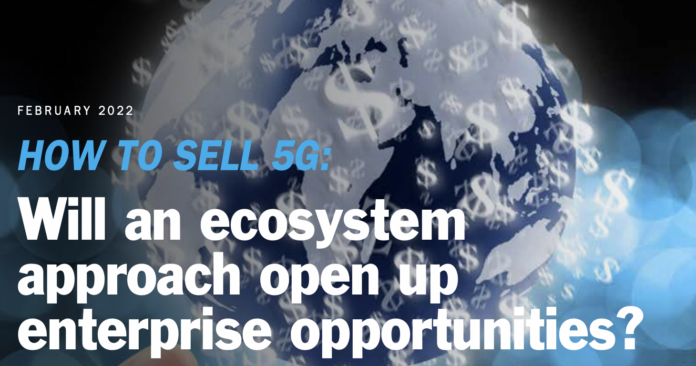5G monetization hinges on partners, ecosystem, and delivering business outcomes
Operators have invested billions in designing and deploying 5G networks but, to date, meaningful new service revenues have proved elusive. This is because 5G monetization is much more than a new network; it’s a new approach to collaboratively developing the solutions that businesses need and selling them in a way that focuses on value creation rather than on commodity technology. Based on recent discussions at Arden Media’s 5G Monetization Forum, and in reporting for a companion report, operators and their partners see a number of routes to 5G monetization, chief among them fixed wireless access (FWA), mmWave, mobile edge computing (MEC), and private networks.
5G fixed wireless access
In the U.S. particularly, operators are using their ongoing 5G mobile network deployments to capture a new line of revenue by simultaneously building out fixed wireless access sites. Verizon and T-Mobile US are both aggressively using their mid-band spectrum to offer home and business broadband services largely in markets where entrenched cable companies control the market or, alternatively, in rural parts of the country where there currently isn’t broadband access.
Verizon’s Jan. 19 C-Band activation marked a major expansion of 5G Business, the operator’s business-facing FWA offering. In a recent interview with RCR Wireless News, Verizon EVP and Business Group CEO Tami Erwin said 5G Business is all about “choice for customers.” She noted that the FWA service, paired with existing national mobility distribution and leadership in every segment served, is a “natural extension” for business customers looking to bundle mobile and fixed broadband. “It really does give customers choice and value,” Erwin said. “The other thing we’re pretty excited about in our promotion at launch is…no price increase for 10 years.”
mmWave in localized hot zones
As enabling technology was developed over the past few years, there was skepticism that mmWave was viable at scale. That line of thinking mmWave was meant as a coverage play which, based on how it is actually being deployed, is indeed not the case. Point being, the technology works and there are all sorts of handset options in market. Now the attention is on the business case and, according to Bell Labs Consulting research, there’s a clear path to monetizing mmWave through strategic deployment in capacity-constrained, localized hot zones.
The Bell Labs Consulting research, based on a dense urban deployment at a transit hub, found operators could achieve a four-year payback and 20% to 30% internal rate of return (IRR) after the payback period. Principal Vikas Dhingra framed the issue: “mmWave has challenges, whether it is on propagation constraints, or whether it is on a lack of spectrum. But what we see as the key opportunity for telecom operators is the monetization of additional data traffic.”
In working to realize the attractive payback period and IRR, operators have to think strategically about where to deploy 5G mmWave. “The key is to deploy 5G mmWave in localized, capacity-constrained areas, such as train stations, stadiums, indoor shopping malls, outdoor areas where there is much higher network capacity needs,” according to Dhingra.
Pubic and private MEC
There’s an adage: MEC doesn’t need 5G but 5G needs MEC. And for any type of latency-sensitive application where milliseconds do indeed matter–things like precision robotics or automated guided vehicles–compute and storage needs to be moved out of centralized data centers and reside closer to where data is created. With decentralized compute and low latency on the air interface, near-real-time decision making based on analytics opens up a host of high-value enterprise use cases.
To the partnership point, this is strongly evidenced in how operators are taking 5G/MEC solutions to market jointly with hyperscalers. And, rather than go all-in on one cloud provider, operators are striking deals with all the major players–AWS, Microsoft Azure and Google Cloud. This gives the operator optionality but also gives them the flexibility to meet customers where they are in terms or organizational preference for one cloud provider over another.
For consumers and SMBs, they may not require a bespoke, on-prem MEC solution. That’s where public MEC nodes, strategically deployed in areas where the demand warrants investment.
Private networks for 4G and 5G monetization
The private networks space is arguably the most competitive and dynamic. Operators are to degrees selling turnkey solutions but, as pointed out by enterprise stakeholders, there are difficulties in scaling down from macro networks to smaller footprints purpose-built to align with particular enterprise use cases.
In terms of competitive dynamics, spectrum access liberalization has removed a key gating factor. This means enterprises can follow a DIY route and procure their own spectrum, equipment, and management or, in some cases, opt to build and manage in-house.
To get an idea of evolving role of operator in delivering private networks, look to Nokia’s deal with managed infrastructure services provider Kyndryl. The two firms will jointly sell and develop private networking and edge computing solutions for the industry 4.0 market. The partnership emerged from collaborative research and a number of joint installations and proofs of concept for Dow Inc.
Learn more in the free report “How to sell 5G: Will an ecosystem approach open up enterprise opportunity?”
Download to read these insights today:

